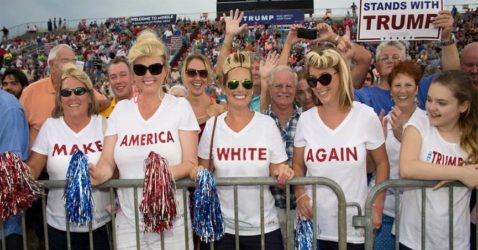 Featured – We Aren’t Seeing White Support for Trump for What It Is. By Thomas B. Edsall / NYT
Featured – We Aren’t Seeing White Support for Trump for What It Is. By Thomas B. Edsall / NYT
On Feb. 24, 2016, after winning the Nevada caucuses, Donald Trump told supporters in Las Vegas, “I love the poorly educated.” Technically, he should have said “I love poorly educated white people,” but his point was well taken. Perhaps most significant, Kitschelt and Rehm found that the common assumption that the contemporary Republican Party has become crucially dependent on the white working class — defined as whites without college degrees — is overly simplistic. Instead, Kitschelt and Rehm find that the surge of whites into the Republican Party has been led by whites with relatively high incomes — in the top two quintiles of the income distribution — but without college degrees, a constituency that is now decisively committed to the Republican Party. Small business owners and shopkeepers — particularly in construction, crafts, retail, and personal services — as well as some of their salaried associates populate this group. Read more
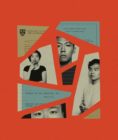 Where Does Affirmative Action Leave Asian-Americans? By Jay Caspian Kang / NYT
Where Does Affirmative Action Leave Asian-Americans? By Jay Caspian Kang / NYT
In a 2004 New York Times article, Henry Louis Gates Jr., the chairman of Harvard’s African and African-American studies department, and Lani Guinier, a professor in the law school, pointed out that while Harvard had increased its black undergraduate population to 8 percent, a majority of those students — up to two-thirds — were international students, first- or second-generation immigrants from Africa or the Caribbean or the children of biracial couples. What was rare, Gates said, was the black student whose four grandparents lived through slavery, Reconstruction and Jim Crow. The truth at Harvard and other elite private colleges is that the supposed zero-sum game of admissions slots isn’t really between Asian immigrants and the descendants of enslaved people, but rather between Asian immigrants, Latino immigrants and black immigrants. Read more
 Remember that new SAT ‘adversity score’? That’s no longer happening. By Kendall Tramell and Chris Boyette / CNN
Remember that new SAT ‘adversity score’? That’s no longer happening. By Kendall Tramell and Chris Boyette / CNN
The nonprofit that administers the SAT college admissions test is replacing its “adversity score” with a tool that will not assign a single number combining high school and neighborhood information. The College Board had introduced the Environmental Context Dashboard as an index that would measure factors, such as crime rates and poverty levels in students’ neighborhoods, to reflect their “resourcefulness to overcome challenges and achieve more with less,” David Coleman, the board’s chief executive officer said in May. Read more
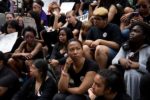 Desegregation Plan: Eliminate All Gifted Programs in New York. By Eliza Shapiro / NYT
Desegregation Plan: Eliminate All Gifted Programs in New York. By Eliza Shapiro / NYT
For years, New York City has essentially maintained two parallel public school systems. A group of selective schools and programs geared to students labeled gifted and talented is filled mostly with white and Asian children. The rest of the system is open to all students and is predominantly black and Hispanic. Now, a high-level panel appointed by Mayor Bill de Blasio is recommending that the city do away with most of these selective programs in an effort to desegregate the system, which has 1.1 million students and is by far the largest in the country. Read more
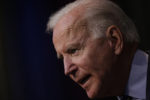 Biden: Racism in U.S. a ‘white man’s problem.’ By Nolan D. McCaskill / Politico
Biden: Racism in U.S. a ‘white man’s problem.’ By Nolan D. McCaskill / Politico
“It’s real,” he said. “It’s there, and the only way — from the founding of this country to today — you deal with it is you attack it. You expose it. You embarrass it. You put people in jail when they engage in things that are illegal when they’re doing it — you call them out. And most of all, you call it out to our children.” “Silence,” he warned, “is complicity.” Read more
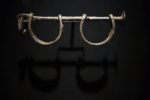 Everyone is talking about 1619. But that’s not actually when slavery in America started. By Ciara Torres-Spelliscy / Wash Post
Everyone is talking about 1619. But that’s not actually when slavery in America started. By Ciara Torres-Spelliscy / Wash Post
As the New York Times noted recently in a blockbuster issue of its magazine, African slavery started in America in 1619. That’s true, but only if you ignore a significant chapter of American history: the Spanish-Afro-American historical experience in Florida. In many parts of the United States, including Florida, Texas and New Mexico, Spanish speakers arrived first. That matters not just for historical accuracy. It also helps reframe the current rhetorical and political upheaval that surrounds immigration from Spanish-speaking nations to the United States, by reminding us how Spanish-speaking black slaves helped build the nation that we now have. Read more
 Why Doesn’t America Have Universal Health Care? One Word: Race. By Jeneen Interlandi / NYT 1619 Project
Why Doesn’t America Have Universal Health Care? One Word: Race. By Jeneen Interlandi / NYT 1619 Project
White legislators argued that free assistance of any kind would breed dependence and that when it came to black infirmity, hard labor was a better salve than white medicine. One hundred and fifty years after the freed people of the South first petitioned the government for basic medical care, the United States remains the only high-income country in the world where such care is not guaranteed to every citizen. Read more
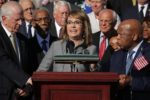 After shootings, El Paso and Latino groups amp up action against gun violence, white supremacy. By Suzanne Gamboa / NBC News
After shootings, El Paso and Latino groups amp up action against gun violence, white supremacy. By Suzanne Gamboa / NBC News
Residents are being urge to channel their grief by taking action after a gunman targeting Latinos left 22 people dead and dozens injured. And that action is taking many forms: The League of United Latin American Citizens held a march and rally in the city’s downtown. Lawmakers are sitting with state officials to come up with a policy roadmap. Benefit and healing concerts are scheduled. “Fight! Fight! Fight!,” former Arizona Rep. Gabrielle Giffords said to residents at a town hall in El Paso last week, urging them to join her in pushing for stricter gun laws. Read more
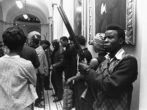 Mass shootings are a call to arms for some black Americans, not a moment for gun control. By Kim Trent / USA Today
Mass shootings are a call to arms for some black Americans, not a moment for gun control. By Kim Trent / USA Today
Black Americans have had a curious relationship with firearms. These weapons were used to keep them subdued during slavery, then terrorized in the Jim Crow south. African-American gun advocates argue that guns also preserved our ancestors’ peace when they were menaced by racists in the antebellum South and the divided North. They argue that, as with all social issues in America, the role of race cannot be downplayed in gun control debates. Read more
 40 Years After I Covered the Atlanta Child Murders, Trauma and Doubt Remain. By Vern Smith / Newsweek
40 Years After I Covered the Atlanta Child Murders, Trauma and Doubt Remain. By Vern Smith / Newsweek
Terror that rises from the threat of a faceless, relentless killer and grows to nearly paralyze an entire community builds slowly. Such was the case of the Atlanta child murders, a series of disappearances and killings of nearly 30 black children, mostly boys and young men, that began in Atlanta in the summer of 1979, when a woman rummaging through the woods for aluminum cans discovered the body of 14-year-old Edward Hope Smith. He had been shot in the back with a .22-caliber weapon. Read more
 Aaron Burr, the Vice President best known for shooting Alexander Hamilton, had a secret biracial family. By Leah Asmelash / CNN
Aaron Burr, the Vice President best known for shooting Alexander Hamilton, had a secret biracial family. By Leah Asmelash / CNN
Here’s something you might not know about the third Vice President: Burr had a whole other family of color, having had two children — one of whom is abolitionist John Pierre Burr — with Mary Emmons, a woman from India. The children’s relationship to Aaron Burr was just acknowledged by the Aaron Burr Association in September. On Saturday, that recognition was literally written in stone, engraved onto a new tombstone and placed upon John Pierre’s previously unmarked grave. Read more
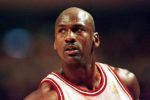 The NBA”s Richest Shoe Deals: LeBron, Kobe and Durant Are Still No Match For Michael Jordan. By Kurt Bandenhausen / Forbes
The NBA”s Richest Shoe Deals: LeBron, Kobe and Durant Are Still No Match For Michael Jordan. By Kurt Bandenhausen / Forbes
Wholesale revenue at Nike’s Jordan Brand subsidiary hit $3.14 billion in the fiscal year ending May 2019, up 10% from 2018. MJ’s annual take is an estimated $130 million, four times more than that of James, the No. 2 earner, with $32 million. Arguably, 16 years after he last laced up his own high tops on the court, more Jordan-branded shoes and apparel are being sold than the signature lines of every other current NBA player. Combined. Read more
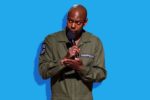 Dave Chappelle’s Sticks & Stones Fights for the Rights of the Already-Powerful. By Inkoo Kang / Slate
Dave Chappelle’s Sticks & Stones Fights for the Rights of the Already-Powerful. By Inkoo Kang / Slate
In his fifth Netflix special, released of Monday, titled Sticks & Stones, Chappelle rails against the perceived softness of many different groups: Louis C.K.’s victims, Kevin Hart’s detractors in the gay community, and Michael Jackson’s survivors, whom he says he doesn’t believe anyway. Read more
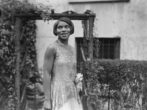 Marian Anderson: The Most Modest Trailblazer. By Anastasia Tsioulcas / NPR
Marian Anderson: The Most Modest Trailblazer. By Anastasia Tsioulcas / NPR
Classical singer Marian Anderson was one of the all-time greats — both as an artist, and as a cultural figure who broke down racial barriers. She is best known for performing at the Lincoln Memorial in 1939, after she was denied permission to sing for an integrated audience at Washington’s DAR Constitution Hall. But she was much more than that — she helped shape American music. Read more
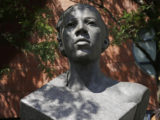 New Statue At U.S. Open Honors African American Tennis Pioneer Althea Gibson. By Richard Gonzales / NPR
New Statue At U.S. Open Honors African American Tennis Pioneer Althea Gibson. By Richard Gonzales / NPR
In a long overdue tribute to the first African American to break international tennis’ color barrier, a new statue of Althea Gibson was unveiled at the opening day of the U.S. Open. The statue is comprised of five granite blocks and created by American sculptor Eric Goulder. It sits outside Arthur Ashe Stadium at the Billie Jean King National Tennis Center in Queens, New York. Read more
Visit our home page for more articles. And at the top of this page register your email to receive notification of new editions of Race Inquiry Digest. Click here for earlier Digests.
Use the buttons below to share the Digest in an email, or you can post to your Facebook, Linkedin or Twitter accounts.